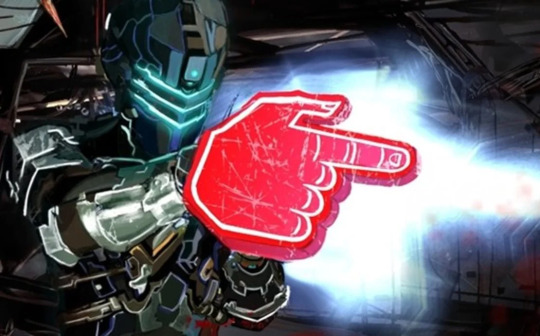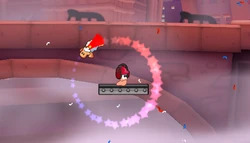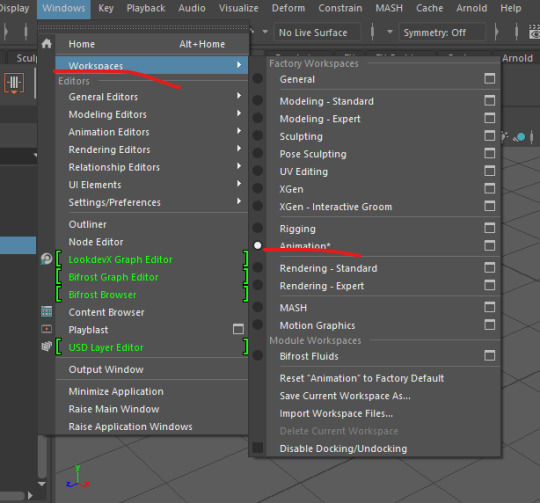Don't wanna be here? Send us removal request.
Text
Particle Effect Research
Particle effects play a critical role in shaping how players experience visuals in games. Here’s a closer look at five games, diving into the specifics of how particles enhance gameplay and environments:
1. Infamous Second Son
youtube
Particle Details: Each power in Infamous Second Son relies heavily on distinct particle effects:
Smoke Powers: Emit wispy, swirling plumes when dashing through vents or attacking enemies. Smoke dissipates realistically, blending into the air.
Neon Powers: Trails of glowing light particles follow the protagonist, creating a vibrant streak of color that stands out at night. When attacking, neon particles scatter like shattered glass.
Concrete Powers: Send chunks of rock flying, with dust particles erupting on impact.
How It’s Used: The particles emphasize the tactile nature of the powers, making every action feel larger than life. Smoke lingers to show destruction, while neon adds a slick, futuristic aesthetic.
Opinion: The particles are a standout feature, helping the powers feel visceral and grounded in the world. The neon effects, in particular, are mesmerizing, making traversal and combat exhilarating.
2. Hogwarts Legacy
youtube
Particle Details: Spells in Hogwarts Legacy use nuanced particles to create visually diverse magical effects:
Fire Spells: Flames erupt with swirling embers and lingering smoke, casting a warm glow on nearby surfaces.
Shielding Spells: Magical shields shimmer with translucent energy and glowing runes. They flicker when struck, breaking apart with spark-like particles.
Levitation Spells: A soft golden glow surrounds objects, with subtle particles sparkling as the object moves.
How It’s Used: Particle effects differentiate spells and provide visual feedback. Fire feels destructive, defensive spells feel protective, and utility spells feel whimsical. Environmental interactions, like fire lighting up shadows, add realism.
Opinion: The spell effects perfectly evoke the Harry Potter universe, balancing spectacle and functionality. Each spell feels magical but still believable within the setting.
3. Fable 3
youtube
Particle Details: Magic in Fable 3 features exaggerated and fantastical particle effects:
Fire Spells: Streams of flame erupt with fiery explosions, leaving scorched marks and ash floating in the air.
Ice Spells: Emit frosty mist and sharp, glimmering ice shards that freeze enemies on impact.
Combined Spells: For example, a fire + tornado spell sends flaming embers and swirling ash spiraling into the sky, creating chaotic, layered particles.
How It’s Used: The over-the-top particle effects emphasize the chaotic, playful nature of magic in the game. They provide clear feedback, with each spell creating dramatic, visual results.
Opinion: The effects lean into spectacle over realism, fitting the game’s whimsical tone. Though not as detailed as modern games, the layered particles in combined spells still feel satisfying and creative.
4. Destiny 2
youtube
Particle Details: Destiny 2 uses highly polished particle effects to enhance its sci-fi universe:
Weapons: Energy rifles and explosives emit dazzling particles, with sparks flying and glowing trails left behind by projectiles.
Supers and Abilities: Abilities like the Warlock’s Nova Bomb explode into radiant, swirling energy, sending waves of glowing particles outward.
Environmental Effects: Planets feature atmospheric particles like dust storms, glowing crystals, and radiant fog that make the environments feel alive.
How It’s Used: Particle effects are central to making combat feel impactful and futuristic. For example, grenade explosions scatter glowing embers, and the lingering effects of a Super move show its massive power. Environmental particles immerse players in alien worlds.
Opinion: The effects are stunningly polished, making combat visually satisfying. The bright and energetic style perfectly complements the game's fast-paced, sci-fi action.
5. The Witcher 3: Wild Hunt
youtube
Particle Details: The Witcher 3 uses more subtle, atmospheric particle effects to immerse players in its gritty fantasy world:
Spells (Signs): Igni sends realistic flames and embers into the air, while Aard creates shockwaves that scatter dust and debris.
Weather: Rain generates soft, dripping particles, while snow creates gentle, wind-blown flakes. Fog rolls through forests, obscuring vision and adding depth to the world.
Combat: Blood splatters and sparks fly during sword fights, adding realism without feeling overly dramatic.
How It’s Used: Particles are used to ground the player in the world rather than overwhelm them. For example, the soft glow of Igni in a dark cave contrasts with the harsher light of flames outdoors, reinforcing the environment’s mood.
Opinion: The particle effects are understated but effective, prioritizing immersion over spectacle. They blend seamlessly into the world, making it feel alive without pulling attention away from the gameplay.
Final Thoughts
Each game uses particles to suit its unique tone and purpose:
Infamous Second Son and Destiny 2 lean into bold, colorful spectacle.
Hogwarts Legacy balances magical whimsy with functional design.
Fable 3 emphasizes creative combinations for dramatic effects.
The Witcher 3 uses subtle, realistic particles to enhance immersion.
These examples show how particle effects can range from atmospheric realism to eye-catching flair, shaping the emotional and visual experience for players.
0 notes
Text
Real Tim Animation in UE5
What I Learned from the Creative Process:
Real-Time Rendering Saves Time: Using Unreal Engine 5 for real-time rendering significantly reduces the time it takes to visualize scenes, enabling faster iteration and experimentation with lighting, camera angles, and effects.
Detailed Pre-Visualization: The team heavily relied on sketches and storyboards early on, allowing them to map out key moments and camera movements before diving into full production. This step ensured a strong creative direction from the start.
Dynamic Camera Work: Unreal Engine's tools enabled cinematic camera movements that feel natural and immersive, giving the animation a polished and lifelike quality typically seen in live-action filmmaking.
How This Applies to My Own Work: One key takeaway is the importance of planning with sketches or storyboards. Even a quick sketch of a scene or key poses can help clarify ideas and keep the project focused before diving into 3D work, saving time in the long run.
youtube
0 notes
Text
What is 3D Animation?
3D animation is the process of creating moving images in a 3D environment using specialized software. It involves modeling characters and environments, rigging them with skeletons for movement, animating actions, and rendering the final scenes.
5 Examples of 3D Animations and Why They Stand Out
youtube
Why Chosen: It showcases intricate creature designs and lifelike animations that bring its ecosystems to life.
What Makes It Unique:
The monsters' animations mimic real animal behaviors, like stalking, sleeping, or territorial fights.
Combat animations are fluid and weighty, giving a sense of realism and immersion.
2. Sekiro: Shadows Die Twice (FromSoftware)
youtube
Why Chosen: Known for its precise, fast-paced animations that perfectly match the game’s combat rhythm.
What Makes It Unique:
The player’s animations, like deflects and deathblows, emphasize fluidity and speed, capturing the samurai aesthetic.
Enemy animations are telegraphed but unpredictable, keeping players on edge and rewarding skill.
3. Arcane (Netflix)
youtube
Why Chosen: A stunning blend of 2D and 3D animation, bringing a League of Legends-inspired world to life.
What Makes It Unique:
Combines painterly, hand-drawn textures with fluid 3D character animation to create a rich, cinematic look.
The subtle character animations, like facial expressions and body language, convey deep emotions and personality, enhancing the storytelling.
4. Spider-Man: Into the Spider-Verse
youtube
Why Chosen: A revolutionary blend of 2D comic-book art and 3D animation.
What Makes It Unique:
Uses frame-staggering and visual effects like comic panels and halftone textures to create a vibrant, comic-like world.
Exaggerated character movements and expressions make every Spider-Person stand out.
5. Horizon Zero Dawn (Guerrilla Games)
youtube
Why Chosen: Features breathtaking animations for both human and robotic creatures in a stunning open world.
What Makes It Unique:
The robotic creatures have unique movement patterns based on their design (e.g., bird-like robots soar while cat-like ones prowl).
Aloy’s smooth transitions between climbing, shooting, and dodging create seamless and immersive gameplay.
These examples highlight the versatility of 3D animation, from creating terrifying monsters and smooth combat to building stylized and emotional storytelling. Each game uses animation to craft a unique identity and experience.
0 notes
Text
What is a Keyframe?
A keyframe in Maya animation is like a snapshot that records an object's properties—things like position, rotation, or scale—at a specific point in time.
How It Works:
Set a Keyframe: You pick a frame on the timeline and save the object's current properties.
Add Another Keyframe: Move to a different frame, adjust the object (like changing its position or size), and save another keyframe.
Maya Fills the Gaps: Maya automatically calculates how the object transitions between the two keyframes, creating smooth motion or changes.
Example:
At Frame 1, you set a keyframe with a ball on the left side of the screen.
At Frame 10, you move the ball to the right side and set another keyframe.
Maya animates the ball smoothly moving from left to right over those 10 frames.
Keyframes are the building blocks of animation—they let you define exactly how things move or change over time.
0 notes
Text
Level Design Psychology and Techniques
1. Player Types
According to Quantic Foundry, players have different motivations when they game, and these can be grouped into types:
Achievers: Love challenges and ticking goals off their list. They want levels that reward skill and effort.
Explorers: Thrive on discovering secrets and hidden paths. Open, interconnected maps are their playground.
Socializers: Prefer levels that let them work together or engage in meaningful story moments.
Recognizing these types helps designers create experiences that appeal to different motivations, whether that’s intense boss fights, secret-filled maps, or co-op puzzles.
2. Shape Theory in Level Design
Shapes can influence how a level makes players feel, according to this article. For example:
Squares/Rectangles: Stable and safe—perfect for hubs or resting spots.
Triangles: Sharp and tense—ideal for danger zones or boss arenas.
Circles: Smooth and harmonious—great for exploration or storytelling areas. Designers use these shapes to subtly guide emotions and actions. A room full of sharp, angular structures? Probably bad news.
3. Blockmesh
Before levels get their final polish, designers often start with blockmesh (or grayboxing). It’s a rough draft of the level using basic shapes to map out:
Navigation: How easy is it to move through the space?
Gameplay Flow: Are there natural highs and lows in pacing?
Player Guidance: Can players intuitively figure out where to go next?
By testing the layout early with blockmesh, designers can make sure the level plays well before adding all the art and details. It’s like sketching before painting—a crucial step in the process.
Understanding what players want, how shapes affect emotions, and why early prototyping matters makes all the difference in level design. Whether you’re building a safe hub for socializers or a tense boss arena for achievers, these techniques help create levels that feel intuitive, exciting, and tailored to the experience.
0 notes
Text
Voxels in Games
How Voxel Style Shapes the Feel of a Game
Voxel graphics use blocky, cube-like designs to create 3D worlds, but how they’re used can totally change how a game feels. Here’s a look at three games—Crossy Road, Minecraft, and Teardown—and how they each use the voxel style in unique ways.
1. Crossy Road

The bright, simple voxel art makes Crossy Road feel lighthearted and super casual. It’s playful and charming, which matches the quick, arcade-style gameplay perfectly. The blocky visuals keep things fun and approachable without being distracting.
2. Minecraft

Minecraft takes voxels to the next level by making them part of the gameplay itself. Everything—characters, landscapes, and tools—is made of cubes, encouraging creativity and exploration. The blocky look feels approachable and open-ended, letting you focus on building, adventuring, or just messing around. Even though it’s simple, it can still feel intense when you’re deep in a dark cave or running from a Creeper.
3. Teardown

Teardown flips the idea of voxels by using them for destruction and realism. It still has that blocky look, but the focus is on smashing and demolishing everything in sight. The destructible environments make it feel tactile and satisfying, blending playful visuals with surprisingly detailed physics.
Comparing the Three
Crossy Road: The voxel style is fun and casual, matching its simple, pick-up-and-play design.
Minecraft: Voxels feel creative and immersive, making the game feel like a limitless sandbox.
Teardown: The style is used for destructibility, making everything feel interactive and real in a tactile way.
Conclusion
Voxel art can be playful and light (Crossy Road), creative and limitless (Minecraft), or satisfying and realistic (Teardown). It’s not just about how the games look—it’s how the blocky visuals make each experience feel unique.
0 notes
Text
Emotional Impact in Games
Horror Games
Horror games like Resident Evil use sound to keep players on edge.
Ambience: Creeping footsteps, distant growls, and the groaning of doors create constant tension.
Music: Sudden sharp strings or eerie silence before a jump scare crank up the fear.
Example: In Resident Evil 2 Remake, the sound of the Tyrant’s heavy footsteps alone can fill you with dread, as they warn you he’s coming long before you see him.
Adventure Games
Games like Monster Hunter use grand, orchestral music to make battles feel epic and exploration immersive.
Monster Themes: Each monster has its own soundtrack to match its personality:
Velkhana’s Theme: Icy, haunting tones that build into dramatic swells, capturing its elegance and danger.
Rathalos’s Theme: Fast, heroic music that adds urgency to fighting the king of the skies.
Environmental Audio: Peaceful sounds like flowing water and chirping birds bring the world to life.
Puzzle Games
Puzzle games use sound to focus or stress players.
Example: Portal combines calm, futuristic music with GLaDOS’s unsettling voice, shifting between peaceful problem-solving and eerie tension.
Contrast between adventure and horror:
Monster Hunter: The series uses dynamic soundtracks that shift with the action, like calm exploration music giving way to intense monster themes. Every fight feels unique because the music evolves with the battle, creating tension and excitement.
Resident Evil: Sound is key to its fear factor. Quiet moments filled with faint drips or creaks build suspense, while sudden jarring noises deliver scares. Positional audio, like hearing the Tyrant’s footsteps grow louder, makes the threat feel real and inescapable.
Conclusion
Sound can make or break the emotional impact of a game. Resident Evil keeps players terrified with ominous audio, while Monster Hunter makes battles feel legendary with epic, dynamic themes. Velkhana’s icy theme and the chilling silence before a Resident Evil scare are prime examples of how sound enhances the emotional experience.
0 notes
Text
UV Maps
A UV map is a way to tell a 3D model how to wrap a 2D texture around it. Think of it like a blueprint that shows where parts of an image should go on a 3D object.
How It Works:
Unwrapping: A 3D object is "unwrapped" into a flat 2D layout, like peeling an orange and flattening the peel.
Mapping: The UV map tells the game engine where each part of the texture fits on the object.
Why It’s Important:
Adding Details: UV maps let you apply textures (like skin, clothes, or wood) to make 3D models look realistic.
Game Performance: Textures give the illusion of detail without making the models too complex.
Creative Design: Artists can design specific patterns and details on the map.
In short, UV maps are what allow 3D models to look polished and detailed in games.
0 notes
Text
Soundscapes in Open-World Games
How Soundscapes Make Open-World Games Immersive
Sound is a key part of making open-world games feel alive. From ambient noises to dynamic music, great sound design helps create a believable, emotional, and interactive experience.
Making Worlds Feel Real
Natural sounds like wind, birds, and rain match environments and make them feel alive. For example, Skyrim uses howling winds in the tundra, while Breath of the Wild captures the peacefulness of nature with rustling grass and soft piano melodies.
Setting the Mood
Music guides emotion, like the calm guitar in Red Dead Redemption 2 during exploration or tense orchestral cues in combat. Creepy sounds in Horizon Zero Dawn mix nature with mechanical hums to keep you on edge.
Interactive and Dynamic Sounds
Sound reacts to your actions, like muffled footsteps in Breath of the Wild’s rain or fading wildlife noises as you approach in Red Dead Redemption 2. It also gives clues, like monster growls in The Witcher 3.
Unique Regional Soundscapes
Different areas have distinct sounds. Red Dead Redemption 2’s swamps buzz with insects, while its plains echo with coyotes. Silence, like in Breath of the Wild, can emphasize vastness or tension.
Why It Matters
Great soundscapes make worlds feel alive, guide your emotions, and enhance exploration. Games like Skyrim, Breath of the Wild, and Red Dead Redemption 2 show how sound can transport you into unforgettable worlds.
0 notes
Text
Sound Design in Games
How Sound Helps Guide Players in Video Games
In video games, sound is more than just background noise—it actually helps guide players and makes the game feel more intense and immersive. In stealth games, for example, sound plays a big role in helping players avoid being detected and react to threats. But the way sound is used can change depending on where the game is made, and what players expect in different cultures.
Sound in Stealth Games
In stealth games like Metal Gear Solid, Splinter Cell, and Assassin’s Creed, sound isn’t just there for atmosphere; it’s essential for how players navigate the game:
Enemy Detection: Footsteps, creaky floors, and other sounds let you know when enemies are nearby. If you hear footsteps getting louder, you know someone’s getting closer, and you’d better hide.
Example: In Metal Gear Solid, you can tell where enemies are by listening to their footsteps, so you can avoid getting caught.
Alert Sounds: If an enemy sees you or hears something suspicious, an alarm or a loud "!" lets you know you’ve been spotted. This helps you react quickly.
Example: In Splinter Cell, if a guard sees you, an alarm goes off, and you know you need to move fast or hide.
Building Tension: Some games use sound to make you feel more nervous. For example, your own heartbeat might get faster when enemies are close, making you feel like you’re in more danger.
Example: In Amnesia: The Dark Descent, your heartbeat speeds up when a monster is nearby, adding to the creepy atmosphere.
Success or Failure: The sound changes depending on whether you’re doing well or failing. If you’re sneaking around undetected, the game stays quiet. But if you get spotted, the music ramps up, and alarms blare, signaling danger.
Example: In Hitman, if you finish a mission without being seen, the game rewards you with calm music to show you did it right.
Sound Design Across Different Cultures
The way sound is designed in games can also change depending on where the game is from and who it’s made for. Different countries have different tastes, so game developers adjust the sound to match local expectations.
Japanese vs. Western Sound Design
Japanese Games: Japanese games often focus on creating a strong atmosphere with subtle, quiet sounds. The goal is to make players feel immersed in the world, sometimes through minimalistic sounds that add tension or fear.
Example: In Silent Hill, the game uses quiet, eerie sounds—like static on the radio and distant sirens—to create a feeling of isolation and dread.
Western Games: Western games tend to have more direct, action-packed sound. The music and sound effects often react directly to what the player is doing, like getting feedback when you hit an enemy or trigger an event.
Example: In The Last of Us, the sounds of footsteps, gunshots, and infected enemies all help you react quickly and stay alert.
Adjusting Sound for Different Markets
Sometimes, game sound gets adapted based on where it's being released. For example, voice acting might change depending on whether a game is in Japan or the West. The music might also be tweaked to better fit what local players expect.
Sound in Other Games
Sound is important in all types of games, not just stealth ones. Here’s how it’s used in other genres:
Puzzle Games: In games like The Legend of Zelda, sound helps you figure out when you’re close to solving a puzzle or finding a hidden item.
Action Games: In fast-paced action games, sound helps you know when you’ve landed a hit or completed a combo, making the experience more satisfying.
Progress and Feedback: Games like The Witness use sound to let you know when you’ve made progress or solved something important.
Good Sound Design
For sound to work well in a game, it should:
Be Clear, But Not Overbearing: The sound cues should stand out enough to guide you, but not be so loud or distracting that they pull you out of the game.
Create an Immersive World: Sound needs to blend into the environment. It’s not just about providing feedback—it’s about making the world feel real and alive.
Change With the Situation: If you’re sneaking around, the game should be quiet. If you’re in danger, the sound should get more intense. The sound should always match the mood.
Sound is a huge part of video games, guiding players and making the experience more immersive. In stealth games, it helps you stay hidden and react to enemies. And across different cultures, sound can be adapted to suit local preferences, making each game feel unique. Whether it’s the eerie silence in a Japanese horror game or the intense action sounds in a Western game, sound plays a huge role in shaping the experience.
0 notes
Text
What is a LERP?
LERP stands for linear interpolation and is commonly used in animation and game development to transition an object between points.
0 notes
Text
Weird weapons in games
Mr. Toots - Red Faction Armageddon

Dubstep Gun - Saints Row

Groovitron - Ratchet and Clank

Mutated Milk - TF2

Cluckshot - Gears of War 3

Hand-Cannon - Dead Space 2

Super Sheep - Worms

0 notes
Text
What is a tag in unreal?
Tags are a system in unreal that lets you give any object certain attributes by giving them a tag. You can give any actor a tag and then create code for things like "turning objects gold" or "increasing their size" when a projectile hits them, and you can make it check for certain tags on hit so it performs these actions on only objects with the desired tags.
0 notes
Text
Creating animations and importing them into unreal
I first created a new scene in Maya and added a cube. I next pressed on the animation tab at the top of the screen to open the animation panel.


I next opened the animation view, and pressed the key input to set a key for my animation. Keys are the spots where the objects saves its transformations, so you can move between multiple keys on a timeline with different transformations done to them, with your object automatically smoothly animating between each key.

I next created a simple animation by moving the cube side to side, creating keys each time i moved the cube.

Bu there was then an issue that meant my animation would move too fast
0 notes






